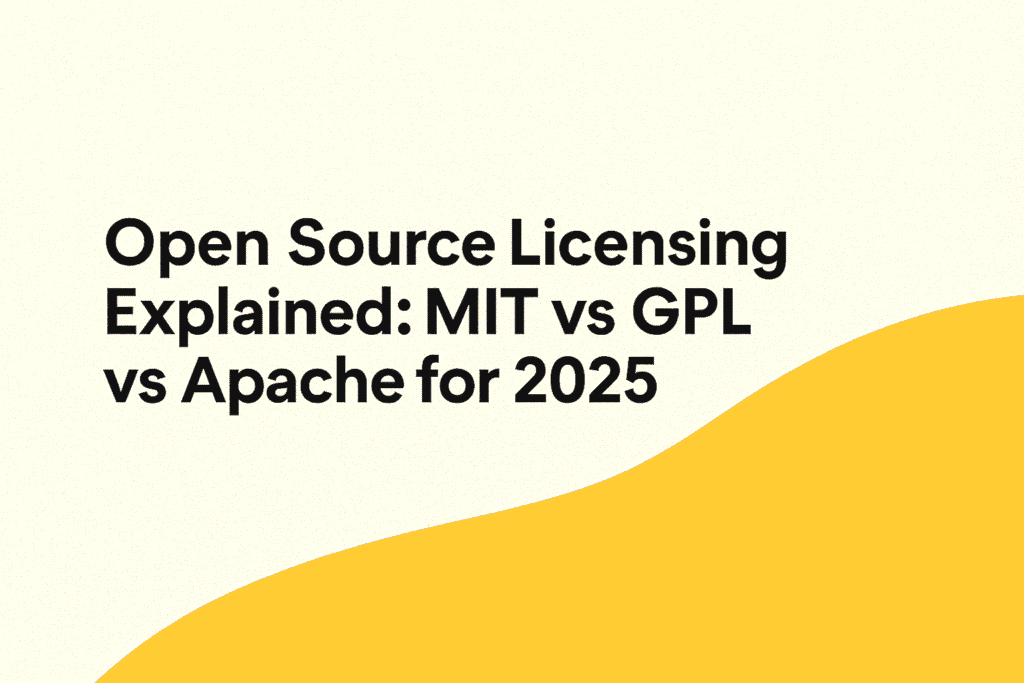In this guide, you’ll discover how the most common open source licenses — MIT, GPL, and Apache — differ, and which one is the right fit for your software or business. Whether you’re comparing MIT vs Apache license or evaluating GPL for your project, choosing the wrong license can lead to legal issues, audit failures, or even lost deals.
What Is an Open Source License?
Open source licenses are legal agreements that define how others can use, modify, and distribute your code. Each license has different rules, from how much freedom you grant users to whether they must share their own code in return.
There are two main categories:
- Permissive licenses (like MIT and Apache) allow flexible reuse.
- Copyleft licenses (like GPL) require open sourcing of derivative works.
Understanding these licenses is a core part of any open source compliance strategy especially if you’re seeking funding, building for enterprise, or planning a product launch.
Why License Choice Matters for Your Business
✅ If you’re distributing software commercially
✅ If you’re using open source in client deliverables
✅ If you’re preparing for a compliance audit
…then your license choices directly affect your risk exposure.
For example:
- Using GPL-licensed code in proprietary products may force you to open source your own software.
- Choosing MIT may expose you to patent risks if not handled correctly.
- Apache includes patent protections, making it safer for enterprise-grade deployments.
That’s why smart companies invest in open source compliance management early.
MIT License: Lightweight and Business-Friendly
🧾 Type: Permissive
🔓 Allows: Use, modify, sublicense, and redistribute
⚠️ Requires: Attribution
MIT is the simplest and most permissive license. It allows anyone to do anything with the code, as long as they credit the original author. No obligation to open source your own code.
Best for:
- Startups
- Internal tools
- Libraries
- Projects needing fast adoption
Watch out for:
- No patent clause
- No warranty coverage
Many early-stage companies use MIT for speed and simplicity, but it should still be reviewed as part of your open source compliance audit.
GPL License: Share-Alike and Strict
🧾 Type: Copyleft
🔒 Requires: Derivative works must also be open source
⚠️ No closed-source redistribution allowedThe GNU General Public License (GPL) ensures that any code built on GPL software is also released under the GPL. This creates strong “viral” effects, which can be risky for commercial products.
Best for:
- Open source platforms
- Nonprofit or community-driven projects
- Software meant to stay public
Not ideal for:
- Commercial or proprietary software
- SaaS platforms using mixed licenses
Important: Many businesses unknowingly include GPL-licensed components and only discover it during a compliance audit.
Apache License: Safe for Enterprise Use
🧾 Type: Permissive (like MIT)
🛡️ Includes: Patent rights grant
📄 Requires: Notice + attributionThe Apache License 2.0 offers the flexibility of MIT but with a clear patent protection clause. This is critical for enterprise products that rely on third-party libraries at scale.
Best for:
- Enterprise software
- SaaS platforms
- APIs or SDKs
- Teams using open source commercially
Why it’s popular: Apache protects against future lawsuits from contributors who might claim patent violations — a key factor in enterprise legal reviews.
Comparison: MIT vs GPL vs Apache
| Feature | MIT | GPL | Apache |
|---|---|---|---|
| Free to use commercially | ✅ | ⚠️ | ✅ |
| Must share your code | ❌ | ✅ | ❌ |
| Patent protection | ❌ | ❌ | ✅ |
| Attribution required | ✅ | ✅ | ✅ |
| Safe for SaaS/Cloud | ✅ | ⚠️ | ✅ |
MIT vs Apache: Which Should You Choose?
When deciding between the MIT License and the Apache License, the key difference comes down to complexity and protection.
Choose MIT if you want a simple, permissive license that allows anyone to use, modify, and distribute your code with minimal restrictions. This is ideal for small projects, personal tools, or startups that prioritize speed over legal detail.
Choose Apache if you need explicit patent protection and are comfortable with a slightly longer license text. Apache is a better fit for larger, collaborative projects or corporate-backed open source initiatives where patent rights are a concern.
Example for developers:
- If you’re releasing a lightweight JavaScript library for the community, MIT keeps it frictionless.
- If you’re building an enterprise-level API framework used across industries, Apache offers stronger legal clarity.
You can read the official license texts here: MIT License and Apache License 2.0.
Which License Should You Use?
Here’s a quick framework:
- MIT: You want simplicity and maximum adoption.
- GPL: You want to enforce openness in all future uses.
- Apache: You want enterprise-readiness and patent protection.
But remember, this choice isn’t just legal it affects partnerships, customer trust, and even M&A value. That’s why smart CTOs include licensing in their open source compliance tools and internal policies.
Need help evaluating your license risks?
🔶 Talk to Yahyou Compliance Experts →
Real-World Scenarios (and Mistakes to Avoid)
🔹 A UAE fintech startup used a GPL library in their payment processor and was flagged during a due diligence check. It delayed their seed round by 6 weeks.
🔹 A US-based SaaS company used an MIT package with known vulnerabilities — their client contract required replacing it and re-auditing the platform.
📌 These situations could have been prevented with proper license vetting and a proactive open source compliance audit.
Final Thoughts
Choosing the right open source license isn’t just a developer decision — it’s a business strategy. The wrong choice can cost you deals, delay audits, or trigger legal risk.
At Yahyou, we help startups and enterprises build secure, compliant, and scalable software foundations with license-aware workflows and open source compliance management.
Need help picking or reviewing open source licenses?
Book a consultation and let our team help you build with confidence.



